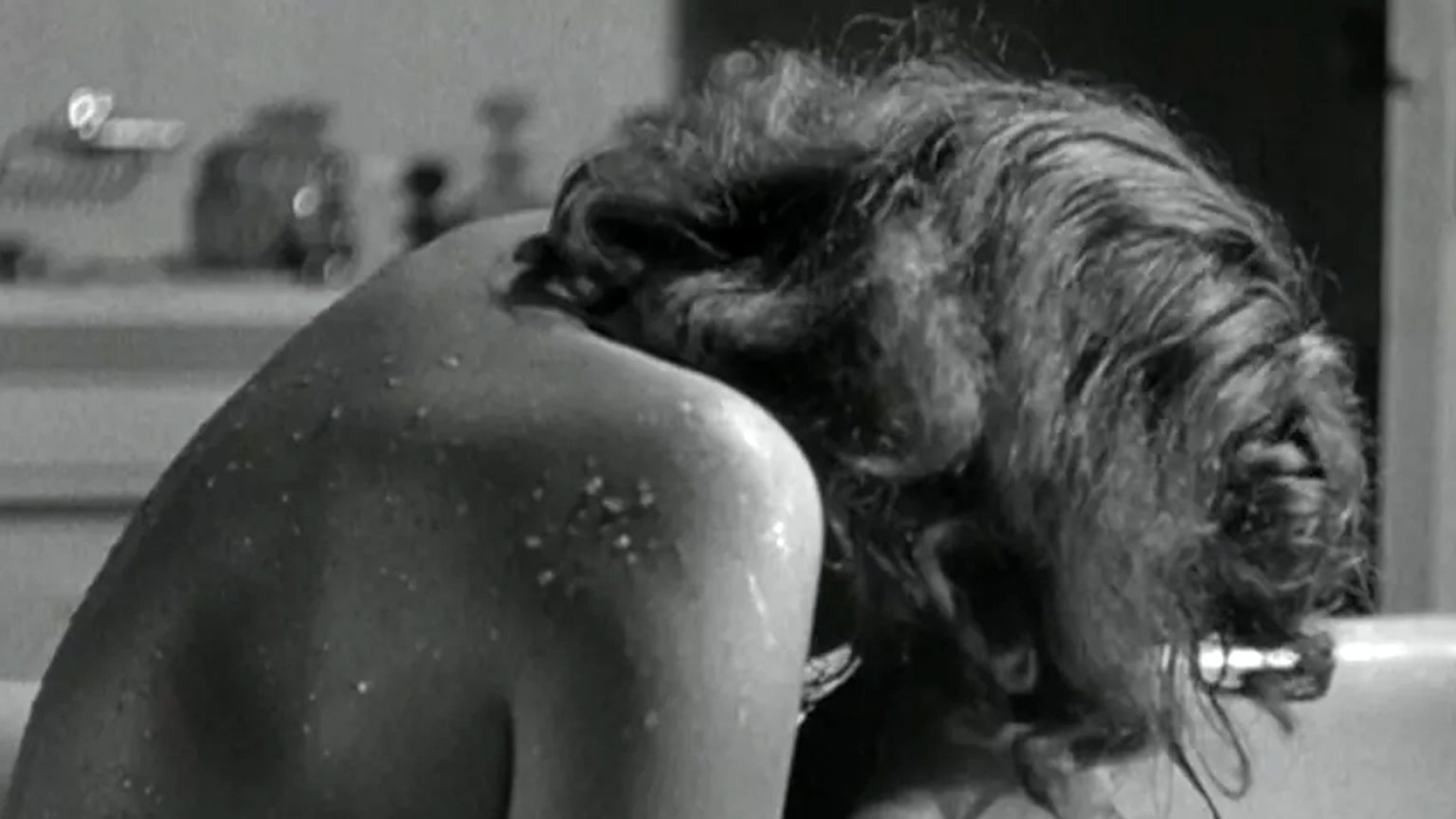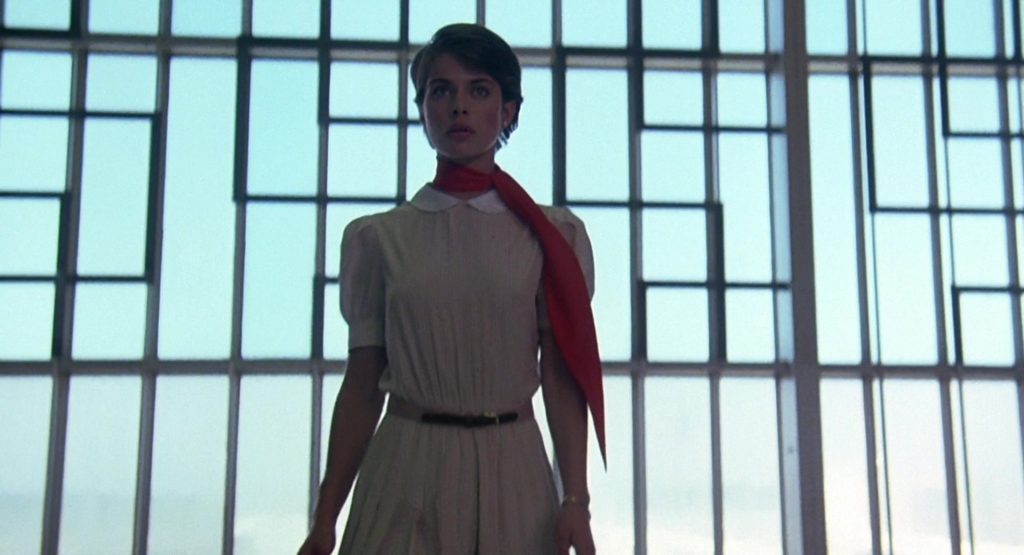If it’s true that nothing in cinema ages worse than horror, what then of the opportunity presented by a horror remake? Allowing that there are far more negligible remakes than good ones—and far more bad horror films than any sane person should ever try to digest—noteworthy remakes of classic horror movies occupy an intriguing corner of cinema, particularly in cases where the original and the update are separated by decades of advancing technology, declining censorship, and critical (re)examination. New Yorkers will have a chance to see one of the cinema’s more curious cases at the BAMcinématek in Brooklyn on the Saturday before Halloween. As part of their series “13 Cats,” BAM is presenting a double bill of both versions of Cat People: the 1942 cult classic, produced by Val Lewton and directed by Jacques Tourneur, and Paul Schrader’s 1982 remake.
Lewton and Tourneur’s Cat People, now out on Blu-ray by the Criterion Collection, holds a place in film history as a landmark of the power of suggestion: the idea that you could make a good horror film on the cheap by simply not showing what everyone is supposed to be frightened of. Place it side by side with Universal Horror’s most iconic box office hits of the 1930s, and you can see how easily monster makeup could be outpaced by shadows, sound design, and heightened subtext all on their own. And the subtext here is certainly fraught with possibility. Irena (Simone Simon), a Serbian loner living in New York, meets Oliver (Kent Smith). He courts her. She responds and invites him into her home. They fall in love. They marry. But Irena, inexperienced, holds back from intimacy with Oliver because of a gnawing fear: that she belongs to a cursed and ancient species, and if she ever becomes too impassioned or sexually aroused, she’ll morph into a vicious killer panther.
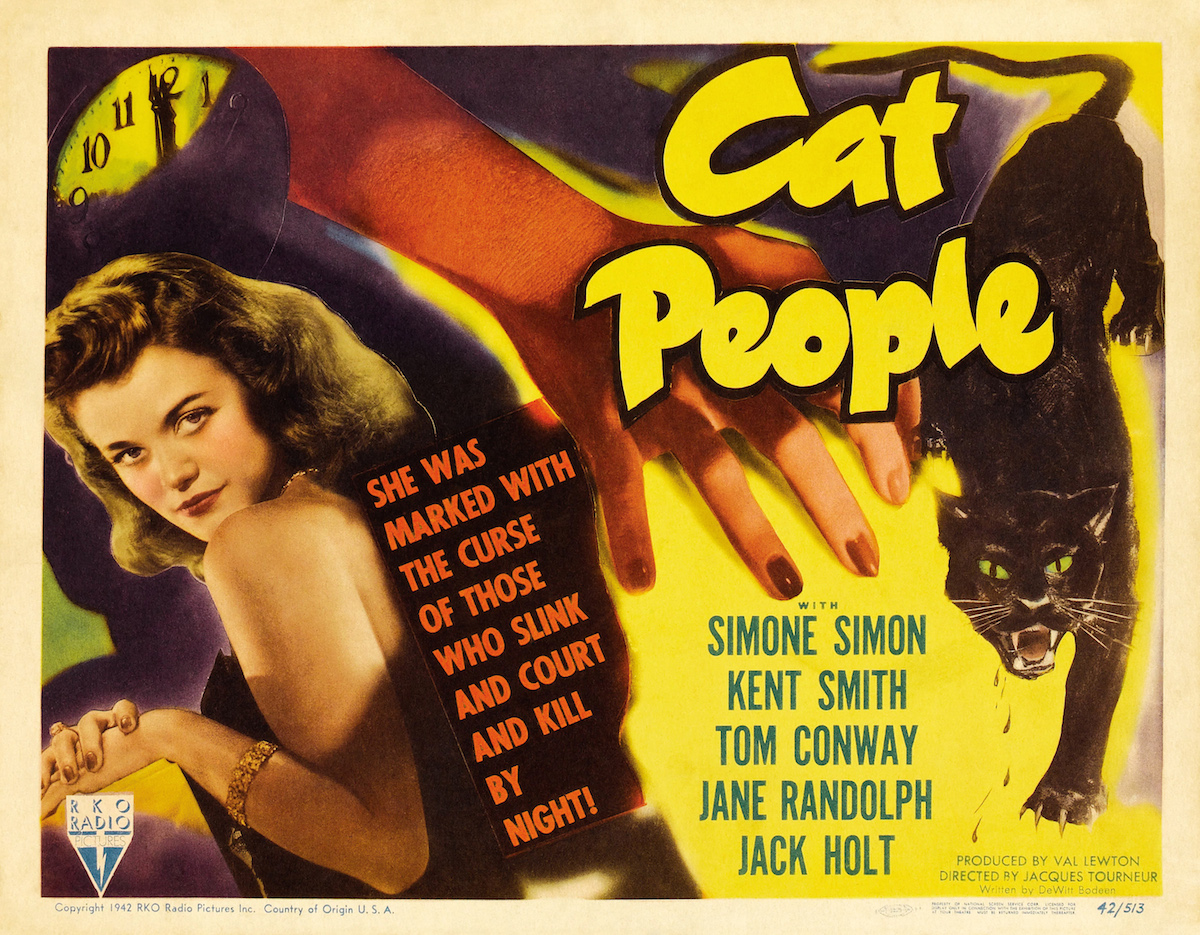
Like so many horror films, it is about the anxiety of being both attracted to and afraid of sexual life—as well as proof, in case any were needed, that the knowing strangeness of cult horror is not a privilege of the present. Lewton’s run of B-movies at RKO has made him one of the relatively rare Old Hollywood producers to be granted a kind of “auteur” status by critics and cinematheques, and Tourneur was his ideal collaborator. Lewton’s films are themselves strange creatures, a mixture of quickie genre requirements and more highbrow aspirations. And thus Cat People was a film that could, not unreasonably, be marketed with a lurid tagline (“…slink and court and kill by night!”) while at the same time being a deeply tragic story of a marriage that closes with a quote about death from the poet John Donne.
Cat People owes much of its effectiveness to the pitch-perfect casting of Simone Simon. As an actress, Simon could seduce or pose glamorously when she needed to, but Cat People is careful to frame her beauty in an uncanny, off-kilter way, as though her physical presence, as much as her accent, is an anomaly in this world. Far more the conventional 1940s Hollywood beauty is Jane Randolph as Alice, Oliver’s coworker and soon the third point in a love triangle, leaving Irena feeling threatened by the healthier, more sexually available woman in her husband’s life. Simon goes from flirtatious to anxious to seething to agonized, unable to find solace in those around her. As much as classical Hollywood can be and has been discussed through the filter of the male gaze, the perspective privileged by this film is largely hers. When she sobs in the bathtub, her naked back exposed to the audience in a startling shot for the 1940s, the nudity of the scene is more emotional than sexual. And it is through her that we register the roles of Alice and in particular Oliver.
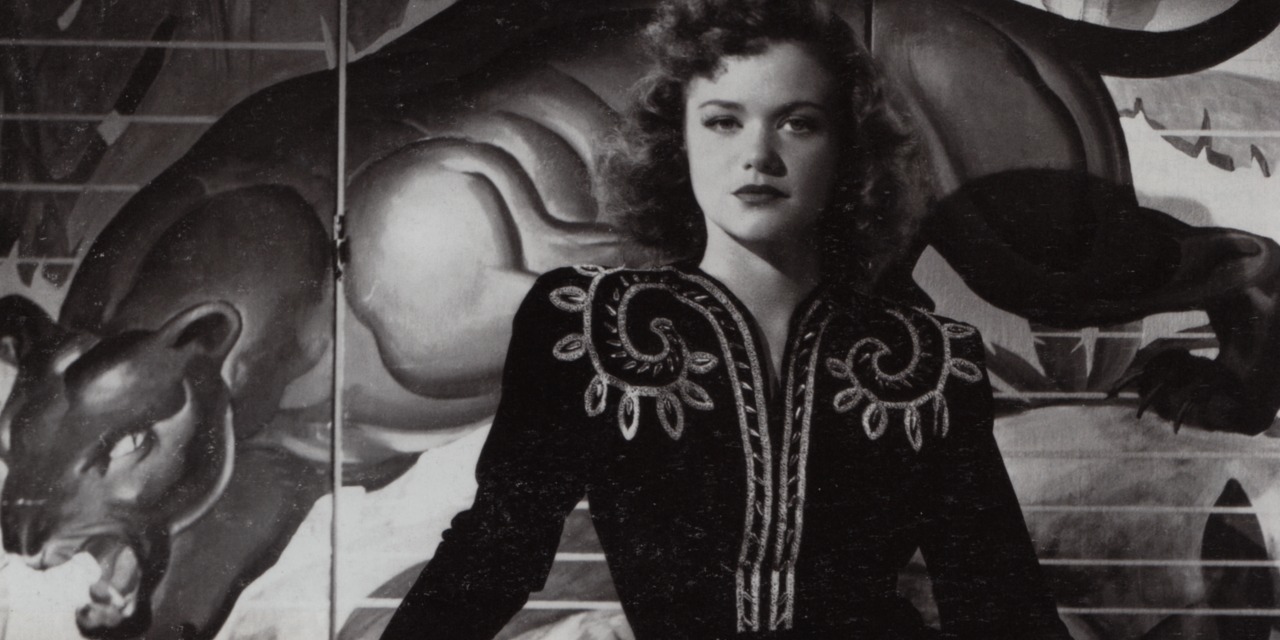
Browsing through the Old Hollywood horror films of the 1930s and beyond, a certain type of bland male romantic lead has a tendency to recur: young, clean-cut, steady, protective, conspicuously slow to catch on to the danger, and sporting perhaps the least vivid personality in the entire picture, as if those films had cracked a code that only the creature and the woman needed to be interesting. (How fortunate, for Cat People, that the two are one and the same). But what’s interesting about Kent Smith’s Oliver is that he looks in so many ways like a parody of these avatars of male presence: handsome, stable—solid husband material, certainly—but also an empty suit of a hero, whose ineffective amiability comes close to outright comedy. (Americachip) While Irena’s inner life boils over supernaturally into the real world, Oliver’s own faint inner life is acknowledged when he briefly recounts his thin backstory, which consisted of always having a “swell” time and never, ever being unhappy—essentially, a sardonic image of what a tortured outcast might imagine a “normal” person to be. The only other man of consequence in Cat People is Dr. Judd (Tom Conway), a psychologist who is called in, as doctors and experts often are in such horror shows, to explain the situation. And in the film’s most subversive note, his attempts to explain Irena, to impose a tidy diagnosis for her psyche, become part and parcel with trying to possess her sexually.
These are the elements that make up the psychodrama of Cat People, a horror movie where much more time is spent on character dynamics than monsters, and where the creature is only hinted at through footprints, heard as growls, and seen as shadows. Its most ingenious special effect is bouncing light off of Simone Simon’s eyes, and there may be no moment in classic horror more soulful than Irena watching Alice and Oliver from the stairs. The film is seventy-three minutes long, and in a modest way, it is perfect.
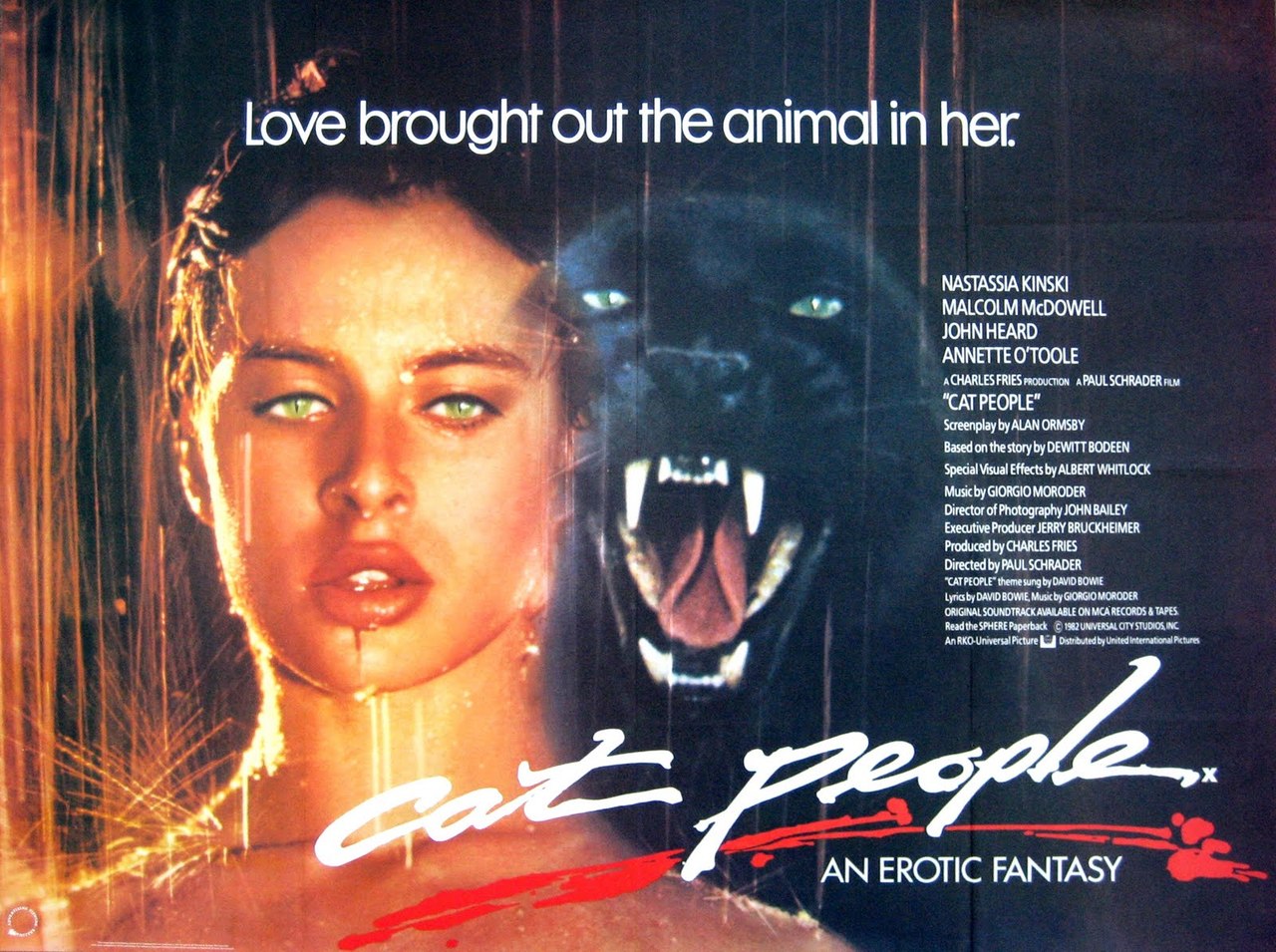
Paul Schrader’s remake is not. But it’s well worth staying for (or seeking out) for anyone interested in flawed yet fascinating films, or in what happens to the power of suggestion in an era when you can show as many breasts and blood-spurts as you like. It is a messy, schizoid film, an uneven mixture of new and old material that lands somewhere between the druggier sci-fi trips of the 1970s and the makeup-and-creature-effects blockbusters of the 1980s. (Accordingly, some of its ’80s trappings, like a Giorgio Moroder synth score and David Bowie theme song, have aged much faster than Tourneur’s use of shadows). Whereas the original is a model of storytelling economy, the remake takes its time focusing on who or what it wants to be about. Yet it’s also a richly weird ride, full of lurid color and fluid, mobile camerawork, playing creative “what if?” games with the source film’s bizarre mythos. It could be that a side-by-side double bill is an ideal way to look at the 1982 Cat People because though it borrows plot points and sometimes exact scenes, it is most interesting, and most valuable when scrambling the dynamics of the original by darting off in its own bonkers direction.
For starters, the biggest shift is that Irena is now cast as a sexpot: Nastassja Kinski, twenty-one years old and cresting as a pinup of chic liberation. Where the original presents a challenge to the idea of a male gaze, the new version is positively drenched in it right from Kinski’s introduction, when the camera catches her alluring face and then follows from close behind, just over her shoulder. Alice (Annette O’Toole) and Oliver (John Heard) are still coworkers, already with hints of romantic attraction between them. Alice, no longer the more sexualized of the two women but still the more experienced is presented as a girl-next-door type, in some scenes complete with pigtails. John Heard’s Oliver comes across at first like a geekier version of Joel McCrea, square, dutiful, and upstanding. That leaves Malcolm McDowell, cinema’s embodiment of the male id, as the franchise’s first cat man and Oliver’s tortured foil, hovering over Irena exactly like the camera and whispering sinful suggestions.
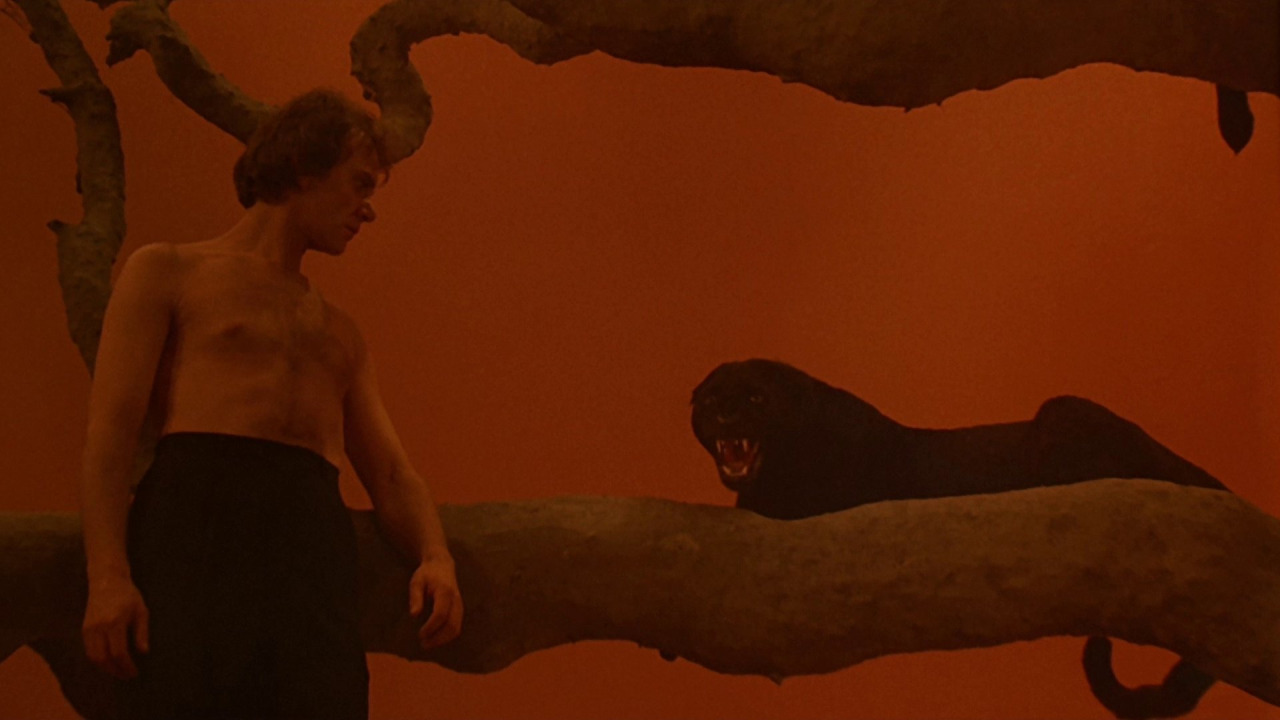
Oddly enough, perhaps the easiest line of distinction between the two versions comes through poetry. Where the original Cat People ended with a tragic stanza from John Donne, the Schrader version offers a poet of its own: Dante Alighieri. Schrader—a critic, screenwriter, and by 1982 a director in his own right—once compared the remake’s conception of Oliver and Irena to Dante and Beatrice, Dante’s exalted feminine ideal and guide through Heaven in the Divine Comedy. To make the link explicit, Oliver is shown quoting and memorizing a sonnet from Dante’s La Vita Nuova about being stricken by Beatrice (“…thy face which is so fair to see…”) immediately before he meets Irena for the first time.
The Dante-Beatrice comparison is provocative, chiefly for all the contradictions it opens up by suggesting a lyric poem and an exercise in erotic horror sleaze might be traced to the same source. Irena’s persona—charming, demure, agreeable, vulnerable, and oh-so-responsive—is as much a male fantasy as Kinski’s naked body. And one only needs to look at the hungry, eager glint in Oliver’s eye when he talks to Irena, or listen to the way he completely evades questions about her from Alice, to see how easily sexual attraction can confuse the poetic with the profane, the spiritual with the carnal.
‘Cat People’ (1982)
Schrader had, famously, scripted Taxi Driver (1976) for Martin Scorsese. In an interview Roger Ebert conducted with the two of them, both alluded to their religious upbringings in their conception of how Robert De Niro’s psychotic loner saw the women of Taxi Driver on a pedestal. Something similar to that film’s virgin-whore complex is at work in Oliver’s gaze at Irena, whose charismatic mystique is perfectly evoked by Kinski but who pointedly, and unlike Simone Simon, never quite registers as real. The film is far more interested in Oliver’s psychology than was its predecessor, and indeed, after the dust settles, he makes a far more interesting protagonist than any of the other characters. If the original made Oliver a blank slate of male obliviousness, here he is closer to the (anti-)heroes Schrader the critic had so closely studied in the cinema of Robert Bresson: an enigmatic pilgrim on a private path, with an eye on the transcendental, a foot in earthly muck, and a spotty record of keeping the two separate.
So the biggest difference between the two films is not the explicit sex and gore, but the fact that we’re ultimately in a story about a man instead of a woman. The novelty is often to the remake’s benefit, even if it leaves avenues unexplored. For instance, if it made more of the relationship between Alice and Irena, it could mine riches from how their rivalry is no longer that of a “normal” woman being hounded by a jealous outcast, but of a “normal” woman being hounded by a sexual daydream whom no woman, not even the real Ms. Kinski herself, could ever hope to live up to. But while the later Cat People may use a male gaze, it is certainly not uncritical. In the film’s most twisted coup, the ending has Oliver trying to balance the real woman in his life with an impossible ideal, and god only knows how long he can last. It is as if, in the 1942 version, Lewton had tried to roll the non-threatening friendliness of Oliver and the predatory leer of Dr. Judd into the same figure. Or it is as if Schrader sensed that even the bland, protective horror heroes of old would have had at least a seed of the McDowell character’s perversion inside them. If the film is more unsettling than erotic, that’s because it knows that putting a woman on a pedestal is so uncomfortably close to putting her in a cage.
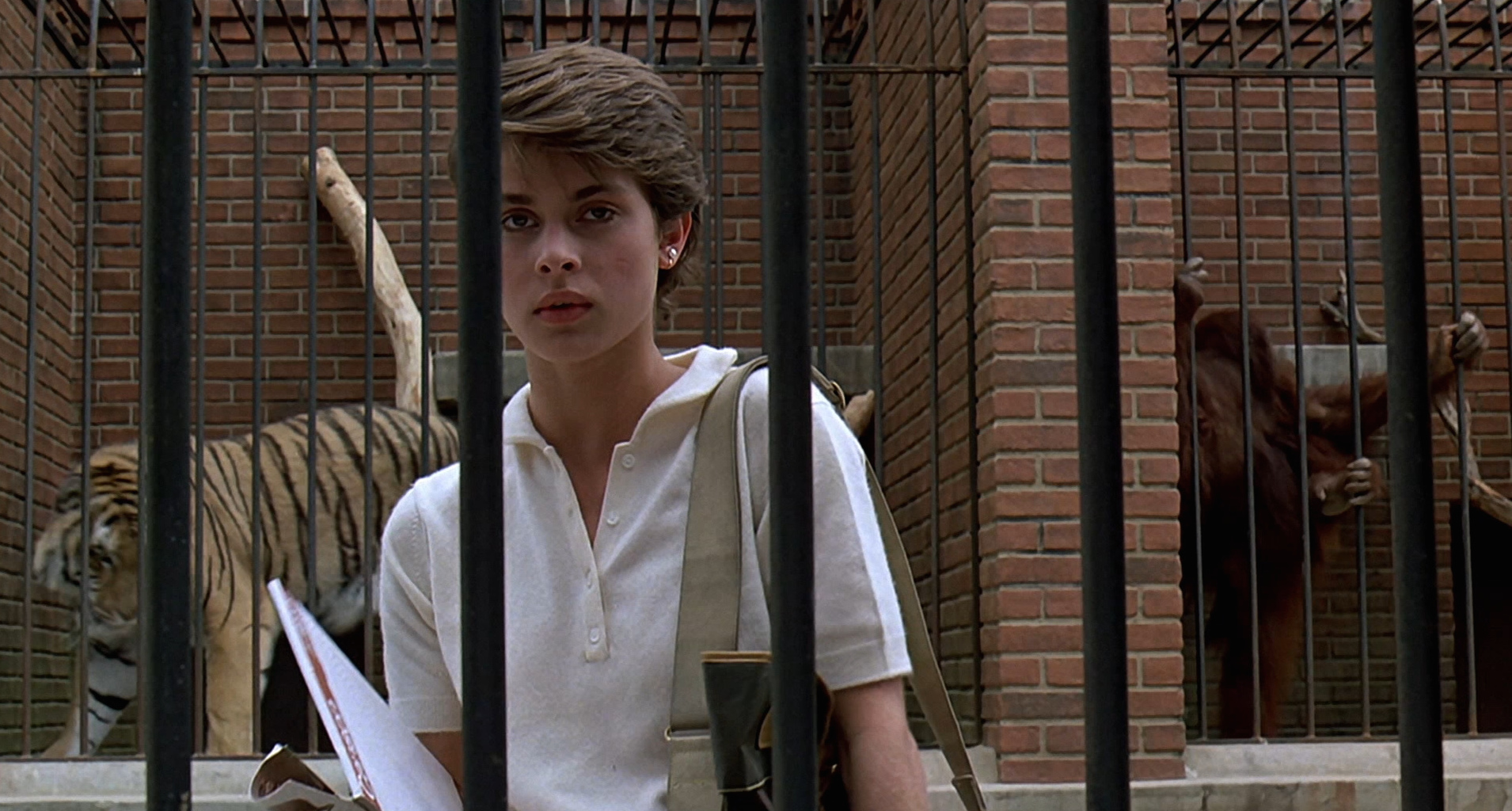
Lewton and Tourneur’s original is still the larger film, despite being a full forty-five minutes shorter, while Schrader’s take earns a cult within a cult. But I like to think that the role of these two “cats” unspooling at the BAMcinématek is to forever circle and nip at one another, like a tangled yin and yang of male and female, anxiety and fantasy, repression and desire. Just don’t be surprised, even for horror films, if the more classical of the two also turns out to be the more modern.
Cat People (1942) and Cat People (1982) will be playing at the BAMcinématek on October 29th.

